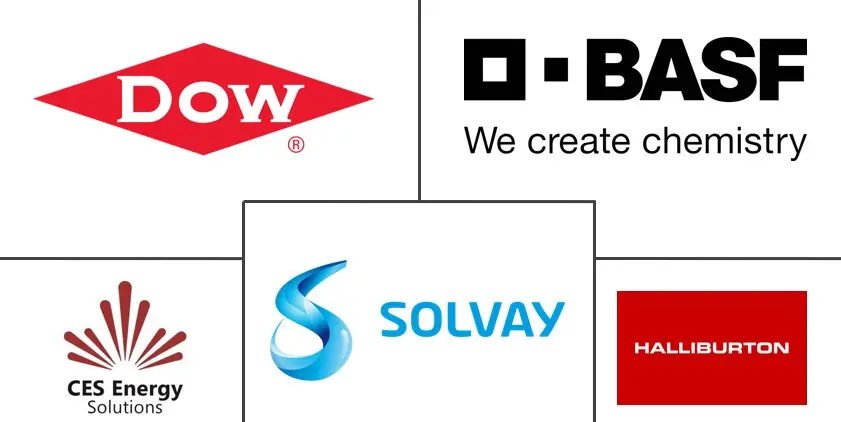Market Size of North America Fracking Chemicals Industry

| Study Period | 2020 - 2029 |
| Base Year For Estimation | 2023 |
| Forecast Data Period | 2024 - 2029 |
| Historical Data Period | 2020 - 2022 |
| CAGR | > 4.50 % |
| Market Concentration | Medium |
Major Players
*Disclaimer: Major Players sorted in no particular order |
North America Fracking Chemicals Market Analysis
The North American fracking chemicals market is expected to record a CAGR of approximately 4.5% during the forecast period. The COVID-19 pandemic had a severe impact on the fracking industry as oil and gas upstream operations were suddenly halted due to low demand for oil and gas and, consequently, low commodity prices. For instance, in the United States, the price of WTI (West Texas Intermediate) crude reached the lowest level of USD 14 per barrel from USD 63 at the beginning of the year. The cost of the fracking process is exorbitantly high, thus is not affordable in a scenario with only a few projects. Factors such as a high active rig count, longer lateral lengths, increased number of frac stages per well, and the amount of fracking fluid used per frac stage are expected to drive the market. However, the market is expected to face hurdles due to volatile crude oil prices and the environmental impacts of hydraulic fracturing.
The horizontal or directional segment is expected to grow at the fastest rate during the forecast period due to the increased number of horizontally drilled wells in the region.
The new alternative fracking technologies, such as waterless fracking, the introduction of green chemicals, propane gel, and other technologies, are expected to create tremendous growth opportunities in the future.
The United States is expected to dominate the market during the forecast period due to the high share of unconventional oil and gas production in petroleum production from the various oil and gas basins present in the country.
North America Fracking Chemicals Industry Segmentation
The North American fracking chemicals market report includes:
| Fluid Type | |
| Water-based | |
| Foam-based | |
| Other Fluid Types |
| Well Type | |
| Vertical | |
| Horizontal or Directional |
| Geography | |
| United States | |
| Canada | |
| Rest of North America |
North America Fracking Chemicals Market Size Summary
The North American fracking chemicals market is poised for growth, driven by factors such as a high active rig count, longer lateral lengths, and an increased number of frac stages per well. Despite the challenges posed by volatile crude oil prices and environmental concerns, the market is expected to expand, with the horizontal or directional segment experiencing the fastest growth. This growth is attributed to the rising number of horizontally drilled wells in the region. The introduction of alternative fracking technologies, including waterless fracking and green chemicals, is anticipated to create significant opportunities for market expansion. The United States is expected to maintain its dominance in the market, supported by its substantial share of unconventional oil and gas production from various basins.
The fracking process, which involves injecting fracking fluid at high pressure to extract oil or gas from difficult rock formations, has become a crucial technique, especially following the US shale gas boom. The Permian Basin, a key tight oil play, has seen increased well productivity, further boosting the horizontal well drilling type. Government investments and private sector interest in oil and gas projects have been significant, with initiatives in regions like the Bakken Formation and the Permian Basin attracting substantial funding. Additionally, offshore projects such as the Mad Dog Phase 2 in the Gulf of Mexico are expected to contribute to market growth. The market is moderately fragmented, with key players including Halliburton Company, BASF SE, Dow Chemical Company, CES Energy Solutions Corp., and Solvay SA, all playing pivotal roles in shaping the industry's landscape.
North America Fracking Chemicals Market Size - Table of Contents
-
1. MARKET OVERVIEW
-
1.1 Introduction
-
1.2 Market Size and Demand Forecast, in USD billion, till 2027
-
1.3 Recent Trends and Developments
-
1.4 Government Policies and Regulations
-
1.5 Market Dynamics
-
1.5.1 Drivers
-
1.5.2 Restraints
-
-
1.6 Supply Chain Analysis
-
1.7 Porter's Five Forces Analysis
-
1.7.1 Bargaining Power of Suppliers
-
1.7.2 Bargaining Power of Consumers
-
1.7.3 Threat of New Entrants
-
1.7.4 Threat of Substitute Products and Services
-
1.7.5 Intensity of Competitive Rivalry
-
-
-
2. MARKET SEGMENTATION
-
2.1 Fluid Type
-
2.1.1 Water-based
-
2.1.2 Foam-based
-
2.1.3 Other Fluid Types
-
-
2.2 Well Type
-
2.2.1 Vertical
-
2.2.2 Horizontal or Directional
-
-
2.3 Geography
-
2.3.1 United States
-
2.3.2 Canada
-
2.3.3 Rest of North America
-
-
North America Fracking Chemicals Market Size FAQs
What is the current North America Fracking Chemicals Market size?
The North America Fracking Chemicals Market is projected to register a CAGR of greater than 4.5% during the forecast period (2024-2029)
Who are the key players in North America Fracking Chemicals Market?
BASF SE, CES Energy Solutions Corp, Solvay SA, Dow Chemical Company and Halliburton Company are the major companies operating in the North America Fracking Chemicals Market.

